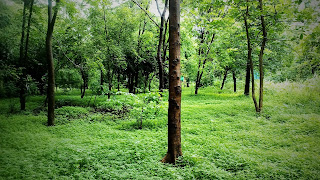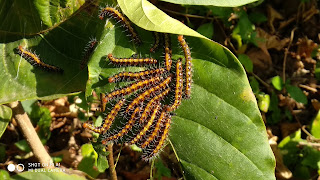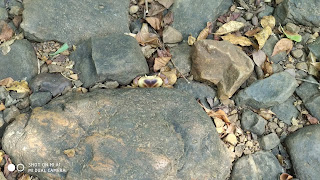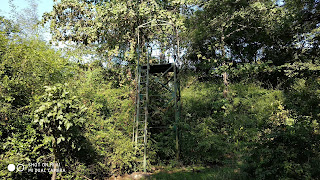Day 1
Not that this was my first trip to the Konkan region. I had been there before. But those times and the occasion did not allow me to delve much into contemplation. After all it was my honeymoon and my trip to Goa did not ignite the spirit to reflect. A honeymoon, after all, does not come again in one's life.
But I had ample time and energy to do so this time, in my trip to Ganapatipule in Ratnagiri district of Maharashtra - a place immersed in holy aura of Lord Ganesha....
Swayambhu (self-originated) Lord Ganesha, I must say. After all, it is not every time that you get an opportunity to travel and see the self-originated idol of Lord Ganesha. The place is religious, culturally rich and holy with spectacular beaches lined up along the Arabian Sea and good food to eat, authentic Maharashtrian food at its best.
We boarded the Mandovi Express at Dadar Terminus and after a stop of about 5 minutes, we were on our way to Ratnagiri. The train was late for about 45 minutes. But it did not deter me from enjoying the journey. I was silent and at ease with myself. I happen to enjoy the journey this way better - enjoying the passing fields, mountains, enjoying the views that the Konkan Railway offers. So with my friends eating and talking along the way, I took my mobile and headset and started to enjoy some music. I am not that socializing kind of a guy, chatting away with friends and talking about the humdrum rituals of everyday life.
Some fellow passengers were sitting in the seat opposite to me; a large family, I thought, coming from Nagpur and travelling for many hours. Two children were sitting besides the window to have a first-hand view of the scenery outside. They, I thought, always have a self-obtained right to have the best places in any journey, whether train, car or other vehicle. An elderly male member of the family was sitting besides me and besides the two children sat their mother, a typically Maharashtrian lady, simply dressed and adorned, with anklets making that tinkling noise every time she would move her hand or legs. The family boarded the train from Thane and were bound for Madgaon, a town in Goa. The mother would offer food at regular intervals to the children and to her husband and to the elderly male member, the husband's father, I supposed. These children were a great help to me because they would count the tunnels that would come and go; this I learnt just when we were about to alight at Ratnagiri. And when we were in the middle of one particularly long tunnel, that lasted for about 7 minutes in duration, I asked those children how many of these tunnels they counted, and they replied, "38 in all." I was both happy and a bit sad. Happy that I had got a great piece of information. Sad, and rather dejected, because, they were doing the same things that I used to do when I was of their age. I slowly realised that, as a child, I had also travelled to faraway places by train and I used to count the tunnels too. Here too, the tunnels had come, but I had forgotten to count them. Why? Because I had grown up? Or was it something else... perhaps the pressures of growing up, that had taken away from me the simple joys of childhood. Perhaps this was life. And it gave me an important lesson. We must enjoy the life that has been given to us and enjoy its every moment and not crib about it. Or else, it will pass in front of us, just as the tunnels had come and gone.
After some time had passed, when the chatting had stopped and the conversations over, all of us in the compartment were relaxing and just letting the scenery go by, wondering what station just went by, or which river came, when the elderly person besides me pulled out a timetable from his coat pocket and started to study it. I glanced and peered over. Seeing this, the elderly man told that the train was 45 minutes late. I acknowledged. He said that all this was the land of Shivaji, the great maratha ruler who resisted the Mughal rule and fought bravely for his country and his land. I realised that we were travelling in Shivaji's country. I was soon transported in times when soldiers on horses would wield swords and marching and defending their lands against the great armies of the Mughals, uttering fierce cries of 'Har Har Mahadev'. The tracks on which our train was travelling were once upon a time, shaking and trembling under the horse's hooves. This was a battle ground on which we were travelling.
It was past lunch hour and approaching late afternoon. It was the time to have tea and we had not eaten a full lunch yet. We had, of course, filled our stomachs with the various snacks that are sold in trains. And they have their charm, too. But they do not give the satisfaction that a full lunch gives. So while, we got tired of waiting for Ratnagiri to come, and complained about the late timing of the trains, Ratnagiri finally came and with it came the energy back to my friends. It was nearing 5 p.m. and the train slowed down and finally came to a stop. We were finally in Ratnagiri, the land of mangoes. We took our luggage and alighted from the train. I, for the first time, walked on the land of the Konkan city of Ratnagiri, birth place of the great social reformer and freedom fighter, Bal Gangadhar Tilak. As I took the first few steps, I glanced up at the sky. It was a view so enthralling.... the wide blue sky, streaked with few clouds, lay uninterrupted by trees or tall buildings; a big blue expanse that was majestic. This was the first of the many beautiful sights that Ratnagiri was to give me.

After some railway formalities, we took a rickshaw and immediately asked for a decent restaurant to eat. It was nearing closing time and many restaurants were just about to serve their last orders. We were lucky as we found a good place to eat. We, of course, did not get to eat a full
Thali, but we ordered for some south Indian delicacies. We refreshed ourselves and renewed our journey to our destination Malgund, where our hotel reservation was done in Atharva Inn. I had insisted from the start of the journey that we must take the famous Arey Warey beach route to Malgund from Ratnagiri. We left Ratnagiri town and soon were driving down winding roads. We were going through open spaces of thick mangrove forests. The traffic on the road was not much but the vehicles were going at a good speed, enough to give one shivers. After some time, the roads started winding upwards and we could see for what we had come here for, the sea. Soon we caught sight of the sea from the few openings in the forests. We were soon travelling over a creek with fishermen's boats and trawlers moored in the middle.

It was not long before we were on a hill and were going on a bend when the view suddenly opened up and besides us lay the vast blue Arabian Sea in all its splendour and the waves touching the shores of the Bhandarpule beach. The view from up the hill was stunning and we could see the sea spread endlessly and the sandy beach looking beautiful. After some time, we were passing over Nevre beach and finally came the twin beaches of Arey Warey. And it kept its promises. Blue mingled with green and the the sun's rays streaked across the blueness, making the scene look almost unearthly and divine. The sea was as if showing a new aspect of its persona, one which we had never seen.

Memories of Shivaji came back to me. Back in school days, we were taught the chapters of Shivaji and his heroics; how he and his army would hide in the thick forests and ambush the enemy and defeat them. Chapter after chapter, filled with tales of countless wars fought with the Mughals and his valour and fearless spirit, came back to me. I knew Shivaji's navy was strong and how his ships would hold off the enemy ships and would guard the coastal waters. Shivaji's navy constituted expert sailors and commanders like Kanhoji Angre and others, but to guard such vast expanses with ships require skills far more superior than an ordinary captain, and this they had in plenty. The sea was not only beautiful and harboured pristine beaches, but it was a battle-ground where cannons used to be fired, and enemy ships sunken. What dreaded scenes this great sea must have hidden beneath its calm waters; what untold lives must be drowned under those waves lapping up the silent shores!!
I was soon awakened from the spell cast on me by the sea and before me the long, winding roads led us closer and closer to Malgund. The roads became less and less narrow and villages appeared before us. The land on both sides was filled with mangrove forests and small houses dotted along the way. Soon we were travelling in a small village and our speed decreased.
We were soon parked before the gates of Atharva Inn, a decent hotel and residency, which would be our lodge and stay in Malgund. We checked in and spent the rest of the evening just savouring the breathtaking scenery that we saw on our way to Malgund.

Malgund is a small village famous for its beach and the birth place of the great Marathi poet, Kavi Keshav Sut. In the evening, we decided to go the main attraction of this place, Ganapatipule Temple. The temple has a great legend behind it and how Lord Ganesha appeared here in the form of an idol. It is situated on the beach itself and one can see the beach, crowded though it is, as it is a very famous place visited by locals and foreigners. A drive of 20 minutes from our lodge brought us to the temple and we offered prayers and our salutations to the great lord Ganesha. After clicking pictures, we sat and enjoyed the beach, where an evening sun was just about to set and send rays of light streaking across the waters. The beach was filled with both local people and visitors and there were camel rides and jet ski rides that would attract anyone who had come for some enjoyment and adventure.
After sunset, we took leave of the beach and strolled along the many stalls and shops selling food, decorative and religious articles. We then, made our way to the restaurant to have our stomachs filled and to satisfy our appetite for pure maharashtrian food. Bhau Joshi's Bhojanalaya, just a few minutes from the Ganapatipule temple, whetted our appetite and made us even hungrier. It was pure, sumptuous maharashtrian food. Never in my life had I tasted such curries and such taste.

After dining, we tried to catch a rickshaw to our hotel. It was approaching 10 p.m. and we could see no sign of any rickshaw that would take us to our hotel. After a harrowing time, which was spent cursing the rickshaws of Ganapatipule and to the long distances that had to be reached only by four-wheelers, and not by walking, we finally called our hotel manager and implored him to come and pick us up. In those hours, the only two things that seemed beautiful were the temple, where the god rested peacefully and slept under garlands and an MTDC resort that was just a few paces from the temple. Fortunately, the hotel manager was a kind man and, true to his word, he came and picked us up from the temple and drove us back safe to the hotel. We thanked him, hailing him as a hero who saved us from our plight and drove to our hotel.
The night was in full bloom and not a sound was to be heard, save some dogs barking or some radio which was put on and was singing from some sleepy house or restaurant which was open in such an unearthly hour. Otherwise, silence prevailed and our hotel manager gave us an valuable piece of advice - come to the hotel by 8 or 8.30 p.m., else you are in for trouble. Alas, we had learnt the lesson a hard way.
After reaching our hotel, we spent some time watching T.V. and while my wife chatted away on the phone, I tried to sleep. Finally, we were resting our heads on the pillows; and while lying there under rugs, my thoughts went back to the unforgettable views of the beaches from the Aare-Waare Road. I was once again in Shivaji's era. When Shivaji was a small baby, his mother put him to sleep by humming lullabies. The song is still famous and many a tale is woven around this. But here there was no lullaby. Horses galloped at full speed and warriors, with swords in their hands, crying out loud slogans fought with enemies. Ships, fully armoured and equipped sent blazing balls of fire shooting across seas. The earth and the seas had became battlefields. A long battle was being fought. Slowly my eyelids drooped and I was sleeping.
Day 2
A new day rose and Malgund beach beckoned us. After finishing our breakfast that included tea, coffee and
poha, we took the road to Malgund and headed for the beach. On the road, we passed open fields full of mango and coconut plantations. Neatly arrayed, they looked spectacular in the background of the open blue sky. After walking for about 25 minutes, we approached the beach. A temple stood on a rock. We ignored this temple and went straight to the beach. We were overjoyed to see the blue and green hued waters of the beach. We went further and we saw seagulls collected at a spot, feeding on little fishes, crabs and other sea food. Occasionally, they would take off in unison and fly off to another spot. We saw small holes all along the coast, which were made by tiny crabs. We saw a middle-sized wading bird standing all alone in the sand and as I went ahead to get a good shot, it flew off.

There were only a dozen people on the beach and we saw jet-skis and some people huddled over a counter that offered rides for money. We stood where we were to appreciate the beauty of the beach. It was a large expanse of sand and water, scarcely visited by people. On my sides, the beach ran till many miles and far away, small rolling hills rose from where we had come and from where we had our first glimpse of the beaches. For many more minutes after that we just stood on the sands, watching the birds catching food or some crab darting and reaching its hole just in time. Only the sound of waves could be heard and nothing else. Shells and cones of different sized could be seen all along the beach. We wanted to reach the waters but were afraid to do so. There was a strong reason for this. The beaches were not safe to swim. Though this beach was comparatively safe, it was not advisable to swim because of the dangerous waters.
After soaking our eyes for some more minutes, we approached the counter and inquired about the fares for the rides. There was four-wheeled scooters that were to be operated by oneself and jet-skis which took to the waters and had to be sailed by experienced men. We enjoyed our rides and after a relaxing time drinking coconut water under a shack, we made our way back to the hotel.
We asked for some good restaurant to have our lunch. And Swad Dining didn't disappoint at all. We had mouth-watering, pure and raw Alphonso mango pulp and maharashtrian thali. The rest of our trip's lunch was assured.

The rest of the day was spent in the hotel and visiting the temple in the evening. In the night, while our wives lay chatting and joking in the hotel, my friend and I took a stroll in the hotel premises. It was 10 p.m. and the sky was dark. No sound could be heard, but the loud laughing of the female members of the family. My friend and I just took the night air in, whispering among ourselves to maintain the peace of the night. How tranquil the night was, how quiet!! We could see no stars but they were there, sure enough, shining and glowing in their own lights. The hotel was bathed in decorative lights of various colours and it dimmed the stars up there. Christmas was just a day away and soon the hotel, along with Ganapatipule would be filled to its limits; and with New Year's Eve a few days away, the quiet of the place will be gone with parties going on all night. I and my friend were lucky to have snatched some moments, just being ourselves, enjoying this stroll in the hotel premises, keeping ourselves silent and in our own thoughts.
Day 3
The day passed without any special event. After a small tiff with my wife, I left the hotel and went to see Malgund's great marathi poet Kavi Keshav Sut's birthplace. The s
marak is a few minutes walk from our hotel and I decided to have a walk, having enough of rickshaw drives. The birthplace, which is now turned to a
smarak, with a library, a hall with photos and books of famous marathi poets and other historical articles and factual materials, is a quiet place with not much noise, except some birds chirping or visitors chatting or taking photographs.
I saw the
kholi or the room where he was born and I was especially amazed at the 20-25 odd erected monuments that had his poems engraved on them.
It was stunning. I was a little dejected and disappointed at not knowing Marathi, or I would have appreciated them. I now knew why Malgund is known as the birthplace of Marathi poetry.
After passing some time at the
Smarak, I left the place and headed to the beach which was just a few minutes walk. It was deserted as it was approaching noon and the heat was draining me. I decided to turn back to the hotel where I passed some time with friends and had a quiet patch-up with my wife.
Evening came and we headed to the temple one last time, as our trip was coming to an end, and decided to do the
pradakshina.
Pradakshina, series of stairs on a small hill, at the bottom of which lies the temple, goes round the hill and ends on the beach. It is a wooded area and one can hear chirping of birds on the trees and on passing by, we saw
kunds or wells which are constructed for bathing. After doing the
pradakshina, we offered our last prayers to Lord Ganesha and headed back to the beach one last time. It was enjoyment time as my wife and our friend's daughter took a camel ride.
Playing with the frisbee was fun too. After sitting on the beach and having our feet wet in the waves of the Arabian Sea, we headed back to the hotel where we danced to the beats of some good music. Night came and we slept.
Day 4
I had insisted that we go to Malgund beach one last time and have that enjoyable scooter ride. So we did and when we were on the beach, we picked up shells and cones that were we so often find on the beach. We spent some 45 minutes doing so and after that we did the scooter ride. Our friend's daughter, afraid at first, finally agreed to do the ride as well and the flush of happiness that came over her face was a delight to watch. She was beaming with joy, a large smile that shot from ear to ear.
We went back and had our lunch at Swad Dining. We were in for a surprise. A famous singer had also come at the hotel and my wife and others were thrilled to see him and also took some snaps, which my wife, very proudly, still carries on her cellphone. It would eventually become her WhatsApp's profile photo. While this was going on, I having the least interest in the famous guest, went to the opposite side of the road and visited a saw mill. The workers working were happy to see me and I took snaps of the place.
Back to the hotel and we chatted for some time and finally after fully thanking the hotel manager for such a wonderful travel experience and fully reimbursing him for the stay, we left Malgund.
We went back to the Arey-Warey road and saw once again those mesmerizing views of the vast, blue Arabian Sea and the beaches.
Visiting Ratnagiri and Ganapatipule was not just enjoyable to us, but it was an opportunity to see first-hand the maharashtrian way of life, the rich culture that we experienced. These are simple beings with simple needs, a primarily agrarian culture, with their roots firmly held in the soils that nourished us with mangoes, coconuts and other vegetables and fruits. These are the very people that take an ox and bullock cart and plough the fields and these are the same people that guarded Maharashtra and its coastal water from the evil hands of the British and the Mughal empires, fighting along with Shivaji - two very different aspects of the same culture.
Though we did not have enough time to visit the forts and other monuments in and around Ratnagiri and Ganapatipule, we vowed to do so on some other appropriate time, when monetary, health and time resources allowed us to do so. I surely missed the forts.
But Ganapatipule was an unforgettable experience. Two things that made an indelible mark on me were the striking views of the beaches and the food.















































